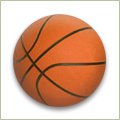 With college basketball practices underway and the NBA season starting, it seems like the H1N1 virus (the virus that causes Swine Flu) has been in the sports news as often as a box score.
With college basketball practices underway and the NBA season starting, it seems like the H1N1 virus (the virus that causes Swine Flu) has been in the sports news as often as a box score.The flu has hit lots of teams already, including Tom Izzo's Michigan State Spartans , the
Washington Huskies , and even Lebron and Company .
Face it - in the US, basketball (H.S., college, and NBA) is a Winter sport and the flu usually rears it's ugly (congested) head around this time of year.
In my opinion, every team should have a flu vaccination policy similar to the Gaucho players pictured above. While flu shots have been available for a while now, it's still not too late to talk to your local doctor about getting vaccinated against "regular" seasonal flu as well as against the H1N1 flu this year.
I wrote about the importance of Taking Your Shot this time last year, but the Swine Flu has added a few wrinkles about what to do.
For an update on recommendations from the US Centers for Disease Control, click here.
And make sure you cover your mouth when you sneeze.
And wash your hands.
And wash your hands.
And wash your hands again.
Here's hoping that the only time you'll ever think about Swine on the basketball court is when you're playing P-I-G.
.jpg)













